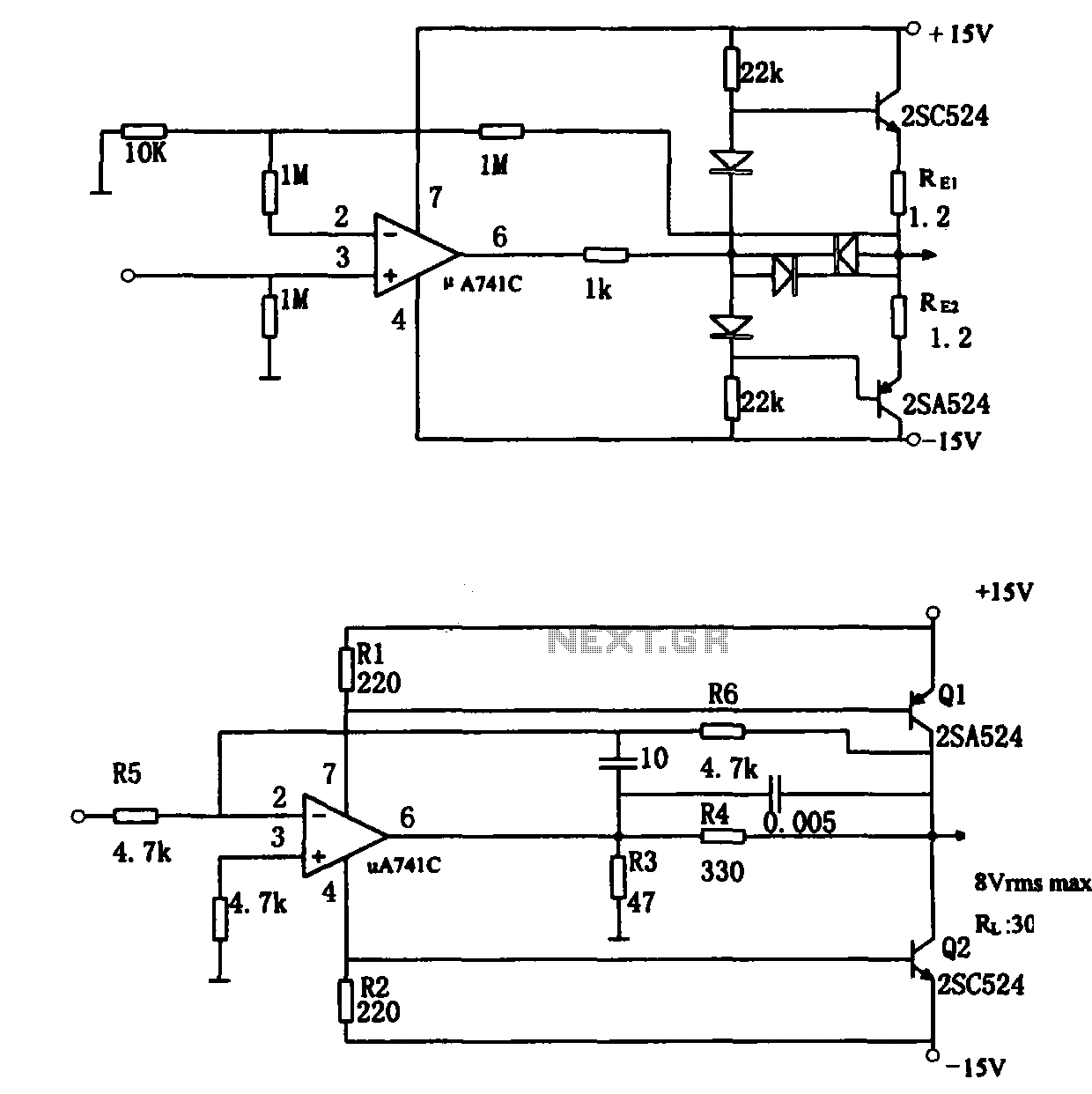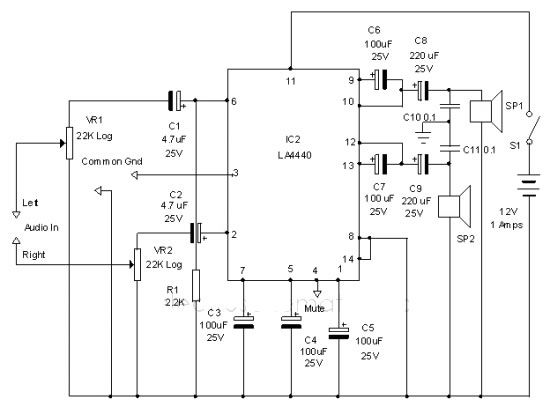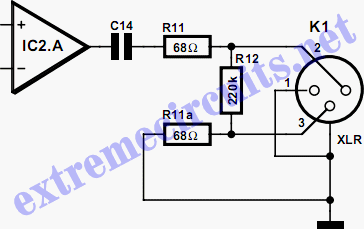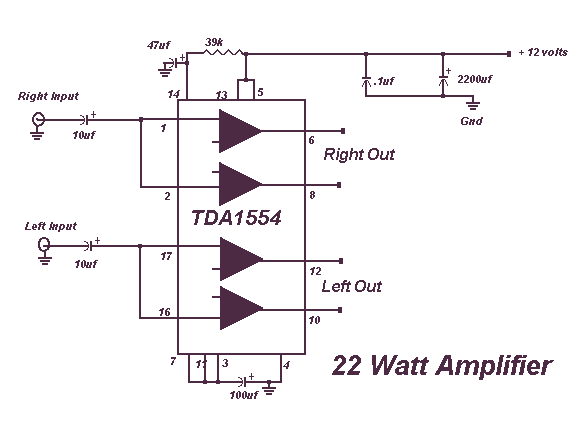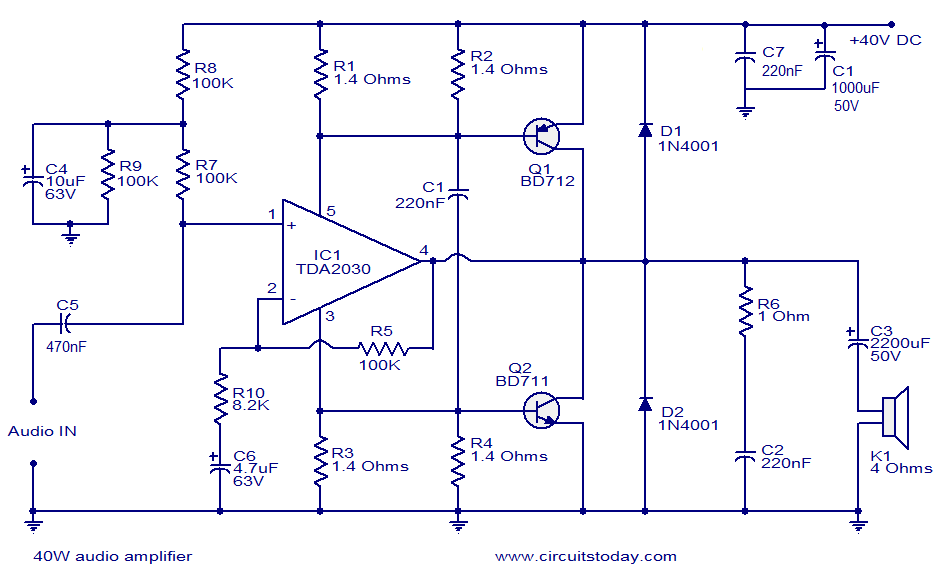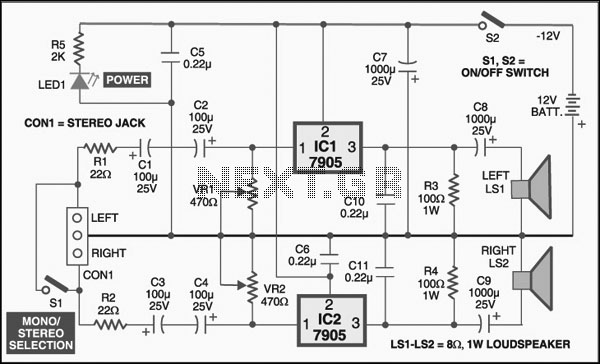
Two Channel Audio Mixer
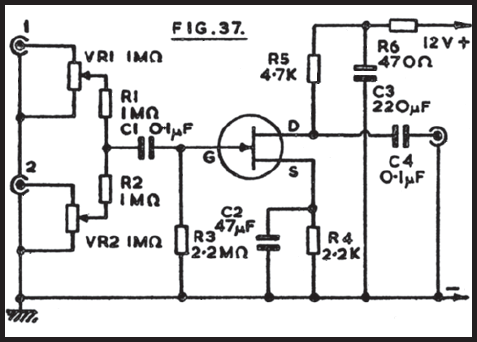
It is often convenient to fade in or out or mix the inputs from two audio sources at any desired level. The circuit depicted is suitable for this purpose. One input connects to socket 1, and the second to socket 2. Each input accommodates high or other impedances and features its own volume control, VR1 and VR2. Resistors R1 and R2 provide isolation between VR1 and VR2, ensuring that a minimum setting for one potentiometer does not ground the other input. This arrangement is appropriate for general applications, including microphones, pickups, tuners, and tape players. The 2N3819 and other audio and general-purpose FETs are suitable for use in this circuit. The output is directed to a screened connector via capacitor C4, configured similarly to another referenced circuit. Power supplies can be integrated as previously described. This mixer can be housed in a compact screened enclosure, which should be grounded to the negative line. The enclosure will accommodate input sockets 1 and 2 along with their respective volume controls. Operation can be powered by an internal battery supply if a connection to the main amplifier is not required. An on-off switch should be included in the positive battery lead. There is some flexibility in component values without significantly affecting performance. Both inputs are amplified; when one input is at a relatively high level, such as from a radio tuner, it may be advantageous to implement a circuit that provides additional gain for that specific input.
The audio mixing circuit described serves to blend two separate audio signals while allowing for individual volume control, making it versatile for various audio applications. The circuit's design features two distinct input channels, each equipped with a volume control potentiometer (VR1 and VR2), allowing the user to adjust the levels of the audio sources independently. The isolation provided by resistors R1 and R2 is crucial in preventing interaction between the two channels, ensuring clean mixing without crosstalk.
The use of FETs, such as the 2N3819, is notable due to their low noise characteristics and high input impedance, which is beneficial for maintaining signal integrity, particularly in sensitive audio applications. The output stage, connected through capacitor C4, serves to block any DC offset while allowing the audio signals to pass through to the next stage of processing or amplification. The design also accommodates battery operation, which enhances portability and flexibility in deployment, particularly in field applications where access to mains power may be limited.
The compact design of the mixer, housed in a screened box, not only protects against electromagnetic interference but also allows for ease of integration into various audio setups. The grounding of the box to the negative line further enhances noise reduction, ensuring that the audio signals remain as clear and undistorted as possible. This circuit can be particularly useful in live sound environments, recording studios, or any scenario where multiple audio sources need to be managed effectively. The option to provide additional gain for one input channel caters to scenarios where a source signal may be significantly weaker than the other, ensuring balanced output levels across both channels.It is often convenient to be able to fade in or out or mix at any wanted level the inputs from two audio sources. The circuit in Figure 37 is suitable for this purpose. One input is to socket 1, and the second to socket 2. Each input is suitable for high or other impedances, and has its own volume control VR1 and VR2. R1 and R2 are to provide isol ation of VR1 and VR2 so that a minimum setting for one potentiometer does not ground the other input. This arrangement is suitable for all general purposes, with microphones, pick-up, tuner, tape, etc. The 2N3819 and other audio and general purpose FETs will be found suitable. Output is to a screened connector, via C4, and is arranged as for Figure 36. Power supplies may also be provided in the same way as already described. Such a mixer can be constructed in a small screened box, which is grounded to the negative line. The box will carry the input sockets 1 and 24 with associated volume controls. Running can be from an internal battery supply, if a power connection is not wanted to the main amplifier.
An on-off switch will then be necessary in the positive battery lead. There is, some latitude in component values, without a very significant change in performance. Both inputs receive amplification. When one input will be at a relatively high level, as from a radio tuner, it may be preferred to employ a circuit in which extra gain is available for one input only. 🔗 External reference
The audio mixing circuit described serves to blend two separate audio signals while allowing for individual volume control, making it versatile for various audio applications. The circuit's design features two distinct input channels, each equipped with a volume control potentiometer (VR1 and VR2), allowing the user to adjust the levels of the audio sources independently. The isolation provided by resistors R1 and R2 is crucial in preventing interaction between the two channels, ensuring clean mixing without crosstalk.
The use of FETs, such as the 2N3819, is notable due to their low noise characteristics and high input impedance, which is beneficial for maintaining signal integrity, particularly in sensitive audio applications. The output stage, connected through capacitor C4, serves to block any DC offset while allowing the audio signals to pass through to the next stage of processing or amplification. The design also accommodates battery operation, which enhances portability and flexibility in deployment, particularly in field applications where access to mains power may be limited.
The compact design of the mixer, housed in a screened box, not only protects against electromagnetic interference but also allows for ease of integration into various audio setups. The grounding of the box to the negative line further enhances noise reduction, ensuring that the audio signals remain as clear and undistorted as possible. This circuit can be particularly useful in live sound environments, recording studios, or any scenario where multiple audio sources need to be managed effectively. The option to provide additional gain for one input channel caters to scenarios where a source signal may be significantly weaker than the other, ensuring balanced output levels across both channels.It is often convenient to be able to fade in or out or mix at any wanted level the inputs from two audio sources. The circuit in Figure 37 is suitable for this purpose. One input is to socket 1, and the second to socket 2. Each input is suitable for high or other impedances, and has its own volume control VR1 and VR2. R1 and R2 are to provide isol ation of VR1 and VR2 so that a minimum setting for one potentiometer does not ground the other input. This arrangement is suitable for all general purposes, with microphones, pick-up, tuner, tape, etc. The 2N3819 and other audio and general purpose FETs will be found suitable. Output is to a screened connector, via C4, and is arranged as for Figure 36. Power supplies may also be provided in the same way as already described. Such a mixer can be constructed in a small screened box, which is grounded to the negative line. The box will carry the input sockets 1 and 24 with associated volume controls. Running can be from an internal battery supply, if a power connection is not wanted to the main amplifier.
An on-off switch will then be necessary in the positive battery lead. There is, some latitude in component values, without a very significant change in performance. Both inputs receive amplification. When one input will be at a relatively high level, as from a radio tuner, it may be preferred to employ a circuit in which extra gain is available for one input only. 🔗 External reference
